13 August
lecture series
CASCANT
Civil architecture in the Ribera de Navarra
Carlos Carrasco Navarro
PhD in Art History
On 13 August 2019, at the auditorium of the Santa Vicenta María Museum in Cascante, a lecture was held on "Civil architecture in the Ribera de Navarra", organised by the Chair de Patrimonio y Arte Navarro, with the help of partnership of the local association Vicus.
The breadth of the topic was limited by focusing on stately architecture from the 16th to 18th centuries, although some examples of civil Baroque architecture such as the Casa de la Obra Vieja and the place de los Fueros, both in Tudela, were briefly discussed.
At the beginning, some terminological clarifications were made regarding the buildings colloquially known as "Palacios de la Ribera", noting that during the Renaissance and Baroque periods, these buildings were known as Main Houses of the Nobility, as palaces were only those of the king or those of the bishop and the dean.
Precisely the social framework from which these buildings arise, the nobility during the Ancien Régime, constituted the first part of the lecture. During the same, its origin and specific features in the Kingdom of Navarre were dealt with, such as the Palacios Cabo de Armería and the criminal process of recognition from which the Ejecutoria de Hidalguía is obtained.
Likewise, the privileges and patronages of the Ribera nobility played an important role, as they had repercussions on such important aspects of the architecture as the omnipresent coat of arms on the façade. Particular attention was paid to the unique ensembles represented by the chapels of board of trustees within the churches, some of which were analysed, such as the Enriquez Chapel in the Church of Mínimos de la Victoria in Cascante.
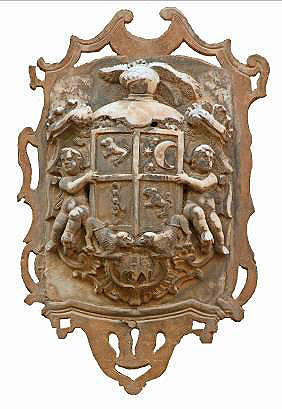
Coat of arms of Igal. Tudela.
This was followed by an analysis of the different examples of main houses during the Renaissance in the city of Tudela: the Palace of the Dean and the houses of Cabanillas Berrozpe (house of the Admiral), Tornamira and Magallón (Marquis of San Adrián). The main differences were then explained between the aesthetics, restraint and balance of the 16th century with an omnipresent courtyard or moon of Aragonese roots, as opposed to the splendour of the Baroque when this courtyard merges with the main staircase, which takes centre stage in the floor plan of the buildings.
At this point, the most important part of the lecture began, with a virtual tour of the main Baroque houses of La Ribera, from Monteagudo to Valtierra, and from Cortes to Villafranca.
Tudela was the first and most dense chapter, with the best and largest examples of houses, establishing itself as the artistic focus of the region. The first of the models is indebted to the Renaissance brick houses with a gallery of semicircular arches, with examples such as the houses of Ezquerra and Labastida. The next is fully Baroque, with imperial staircases under large domes such as those in the houses of Huarte and Montesa. Later came a Rococo model with balconies on bulbous plaster feet, such as the houses of Veraiz and Arizcun. Finally, the victorious aesthetic is classicism with plastered façades such as the houses of Aperregui and Gonzalez de Castejón.

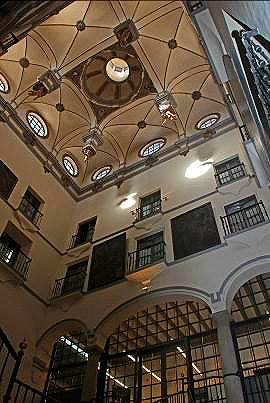
House of Huarte. Tudela.
The second most important city, which was the focus of another chapter of lecture , was Corella, with essential examples such as the houses of Sesma, Miñano and Sopranis, where the mural decoration with geometric motifs in Issue, with white plaster borders and Mudejar tradition, stands out as a local singularity.
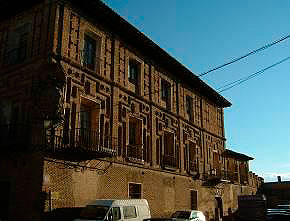
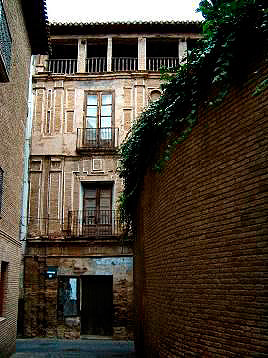
House of Sesma and house of Sopranis. Corella.
We then went on to analyse different houses in Cintruénigo, such as the Navascués houses, the first of which, the one that has disappeared in front of the church, and the other, in Ligués street. The different houses in Ligués, one on the road to Madrid and the two at place of the Town Hall, have another of the most singular motifs of the town's stately architecture: the classicist pediments on the large balconies. Finally, the Loygorri house and its Spanish-American motifs of profile mixtilinear origin were discussed.
The town of Cascante also has important Baroque houses, such as that of the Bobadilla family with its outstanding balcony finials with lintelled arches with core topic under arches, made with brick reliefs. The house of Duplá still has the plaster feet of profile concave and an evenerate floor plan, which is something important to note in the terrifying panorama of the destruction of the heritage of this subject of constructions. The castle of neighbouring Monteagudo, rebuilt during the 18th century by the Marquis of San Adrián, was also mentioned.

Monteagudo Castle.
To conclude, in addition to some examples in other localities, the examples preserved in Villafranca were discussed, especially the house of the Bobadilla family which, together with the Parish Church of Santa Eufemia and the Convent of the Carmelites, is the best Baroque urban complex in the Ribera de Navarra.
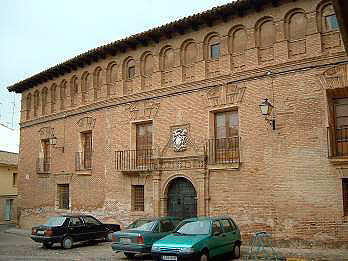
Bobadilla House. Cascante.
